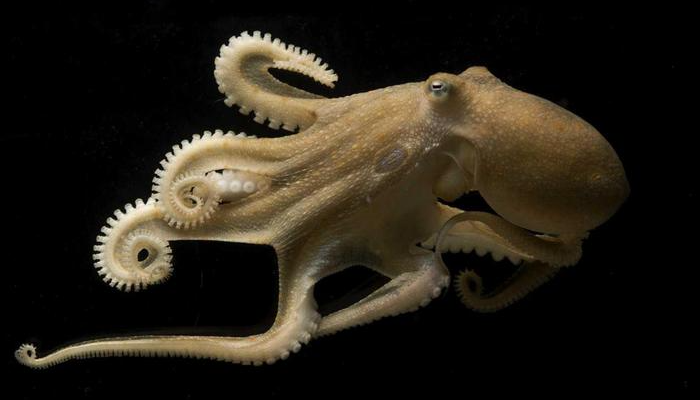How an Antarctic Octopus Adapted to the Cold
Of all the adaptations that enable an Antarctic octopus to thrive in seawater as cold as –1.8 °C, among the most crucial are those of its catalyst proteins, or enzymes. If the ambient temperature is too low, an enzyme typically can’t draw enough thermal energy from its surroundings to do its job. An enzyme can adapt to operating at low temperatures by becoming floppier. But if the enzyme is among the many that span the cell membrane, it must also contend with temperature-induced changes in the properties of the membrane lipids, which grip the enzyme like a collar. Now Miguel Holmgren of the National Institutes of Health in Maryland and his colleagues have identified which genetic mutations to a transmembrane enzyme confer cold adaptability to the Antarctic octopus Pareledone sp. [1]. Although 12 mutations are involved, it turns out that one of them is more important than the rest.
The enzyme that Holmgren and his collaborators studied is the ion pump Na+/K+-ATPase. This enzyme catalyzes the decomposition inside the cell of the chemical fuel known as adenosine triphosphate (ATP). The decomposition of ATP provides the enzyme with the energy it needs to change shape and to release three sodium cations (positively charged ions) from inside the cell to the outside. Once the sodium cations have escaped, two potassium cations from outside the cell take their place, which the enzyme then releases into the cell.
Na+/K+-ATPase plays a vital role in several cellular processes. For instance, during the transmission of neural impulses, ambient sodium and potassium ions flow down their concentration gradients, passing into and out of cells, respectively. Using the chemical energy it extracts from ATP, Na+/K+-ATPase pushes the ions back up their respective concentration gradients in preparation for the next neural firing.
Each reaction cycle of Na+/K+-ATPase results in a net positive charge leaving the cell. To determine which protein mutations sustain that ion flow in frigid water, Holmgren and his colleagues used the following genetic-engineering technique: they inserted into the egg cells of the African clawed frog RNA that encodes various mutants of the Na+/K+-ATPase from a Californian species, Octopus bimaculatus. After a few days, the egg cells sprouted the genetically engineered ion pumps. For each mutant the team then measured the electric current passing across the ion pumps to infer the net outward flow of ions from the cells and its dependence on ambient temperature.
The results show that 12 mutations collectively turn the ion pump from O. bimaculatus, which lives in waters of 14–20 °C, into one that works below 10 °C as well as the one from Pareledone sp. The Na+/K+-ATPase from O. bimaculatus is made up of 1029 amino acids. The researchers discovered that the 312th amino acid is the crucial one in determining how well the ion pump works at low temperatures.
The structure of Na+/K+-ATPase as derived from cryoelectron microscopy indicates that the position occupied by the crucial amino acid in Pareledone sp. is both near the extracellular funnel and next to the lipids of the cell membrane. This proximity to the cell-membrane lipids relates to another cold-water adaptation: at low temperatures, biological fluids and membrane lipids become more viscous. To retain flexibility at these conditions, cells must regulate the mix of lipids in their membranes. George Somero of Stanford University studies cold adaptation in marine animals. He points out that although this fluidity regulation has been known for some time, the amino-acid mutation that bestows the protein with the requisite flexibility was not. “This [study] shows that the proteins also play a role in maintaining catalytic power as temperature changes.”
Somero also says that the work of Holmgren and his colleagues has implications for climate change. Depending on the species and extent of thermal stress, membrane lipids can rebuild their structures—and maintain a stable viscosity—within hours to days. However, genetic adaptation, which would likely be needed to alter the flexibility of transmembrane proteins, takes far longer and thus may not be able to keep up with rising ocean temperatures.
–Charles Day
Charles Day is a Senior Editor for Physics Magazine.
References
- G. Galarza-Muñoz et al., “Molecular determinants for cold adaptation in an Antarctic Na+/K +-ATPase,” Proc. Natl. Acad. Sci. U.S.A. 120 (2023).





